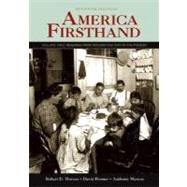
Note: Supplemental materials are not guaranteed with Rental or Used book purchases.
Purchase Benefits
What is included with this book?
| Preface | v | ||||
| Studying and Writing History | ix | ||||
| PART ONE After the Civil War: New South and New West | 1 | (48) | |||
|
|||||
|
2 | (6) | |||
|
|||||
|
|||||
|
8 | (42) | |||
|
|||||
|
|||||
|
16 | (1) | |||
|
17 | (10) | |||
|
|||||
|
|||||
|
27 | (6) | |||
|
|||||
|
|||||
|
33 | (4) | |||
|
|||||
|
|||||
|
37 | (8) | |||
|
|||||
|
|||||
|
45 | (4) | |||
|
|||||
|
|||||
| PART TWO The Gilded Age: Industrial Growth and Crisis | 49 | (50) | |||
|
|||||
|
50 | (8) | |||
|
|||||
|
|||||
|
58 | (9) | |||
|
|||||
|
|||||
|
67 | (2) | |||
|
69 | (1) | |||
|
|||||
|
|||||
|
76 | (1) | |||
|
|||||
|
|||||
|
84 | (1) | |||
|
|||||
|
|||||
|
90 | (1) | |||
|
|||||
|
|||||
|
96 | (1) | |||
|
|||||
|
|||||
| PART THREE An Age of Reform: Responses to Industrial America | 99 | (50) | |||
|
|||||
|
100 | (12) | |||
|
|||||
|
|||||
|
105 | (6) | |||
|
|||||
|
|||||
|
111 | (1) | |||
|
112 | (1) | |||
|
|||||
|
|||||
|
119 | (1) | |||
|
|||||
|
|||||
|
127 | (1) | |||
|
|||||
|
|||||
|
131 | (1) | |||
|
|||||
|
|||||
|
139 | (10) | |||
| PART FOUR A New Society: Between the Wars | 149 | (56) | |||
|
|||||
|
150 | (11) | |||
|
|||||
|
|||||
|
157 | (3) | |||
|
|||||
|
|||||
|
160 | (1) | |||
|
161 | (1) | |||
|
|||||
|
|||||
|
171 | (1) | |||
|
|||||
|
|||||
|
178 | (1) | |||
|
|||||
|
|||||
|
186 | (1) | |||
|
|||||
|
|||||
|
193 | (12) | |||
| PART FIVE "The American Century": War, Affluence, and Uncertainty | 205 | (56) | |||
|
|||||
|
206 | (19) | |||
|
|||||
|
|||||
|
215 | (8) | |||
|
|||||
|
|||||
|
223 | (2) | |||
|
225 | (1) | |||
|
|||||
|
|||||
|
232 | (1) | |||
|
|||||
|
|||||
|
239 | (1) | |||
|
|||||
|
|||||
|
247 | (1) | |||
|
|||||
|
|||||
|
257 | (1) | |||
|
|||||
|
|||||
| PART SIX Contested Boundaries: Moral Dilemmas at Home and Abroad | 261 | (60) | |||
|
|||||
|
262 | (17) | |||
|
|||||
|
|||||
|
269 | (9) | |||
|
|||||
|
|||||
|
278 | (1) | |||
|
279 | (1) | |||
|
|||||
|
|||||
|
285 | (1) | |||
|
|||||
|
|||||
|
294 | (1) | |||
|
|||||
|
|||||
|
301 | (1) | |||
|
|||||
|
|||||
|
311 | (10) | |||
| PART SEVEN: New World Order? Angry Realignments after the Cold War | 321 | ||||
|
|||||
|
323 | (10) | |||
|
|||||
|
|||||
|
327 | (5) | |||
|
|||||
|
|||||
|
332 | (1) | |||
|
333 | (1) | |||
|
|||||
|
|||||
|
340 | (1) | |||
|
|||||
|
|||||
|
345 | (1) | |||
|
|||||
|
|||||
|
351 | (1) | |||
|
|||||
|
|||||
|
356 | (1) | |||
|
|||||
|
The New copy of this book will include any supplemental materials advertised. Please check the title of the book to determine if it should include any access cards, study guides, lab manuals, CDs, etc.
The Used, Rental and eBook copies of this book are not guaranteed to include any supplemental materials. Typically, only the book itself is included. This is true even if the title states it includes any access cards, study guides, lab manuals, CDs, etc.